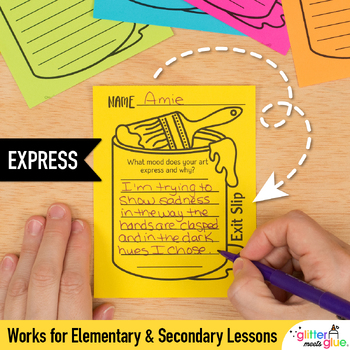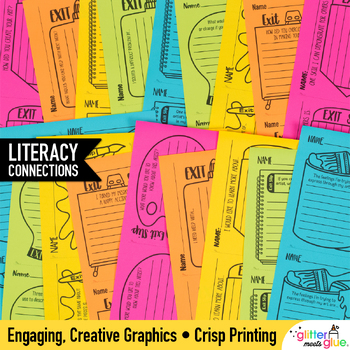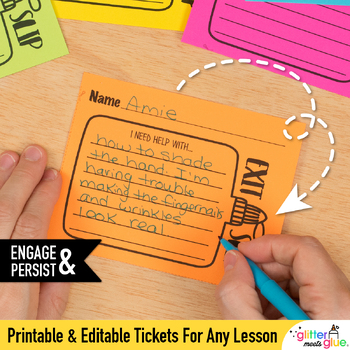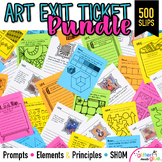Art Exit Slips: 100 Editable Exit Tickets & Writing Prompts for Elementary Art
- Zip
What educators are saying
Also included in
- Never make another art exit slip again! Take back your nights and weekends struggling to come up with bell ringers and exit tickets for your elementary and middle school art curriculum. No more figuring out the perfect ending to your observation lesson. Imagine having 500 drawing and writing promptsPrice $26.99Original Price $30.00Save $3.01
Description
Art exit slips are an easy way to check for understanding at the end of your elementary or middle school art lesson. These 100 art exit tickets are aligned to the Studio Habits of Mind and are an effective art assessment tool. Create custom bellringers and exit slips tailored to your art curriculum using an editable PowerPoint.
Either way, these writing prompts will communicate complex art ideas and give valuable feedback no matter where you are on the choice spectrum.
TEACHER DIRECTIONS
There are a few different ways to use these exit tickets, whether it be at the end of a lesson or a unit of study.
For example, you could pre-select an exit slip and give everyone the same prompt to complete during the last few minutes of class. So, if you're teaching about the history of Ancient Greek pottery, you might consider picking the writing prompt that reads, "How do we learn from the past by looking at ancient art?" from the Understand Art Worlds SHOM standard.
Or maybe you've just completed a printmaking unit and you want your students to demonstrate they understood the process. You might want to use the exit ticket prompt that reads, "How did you create your art?" from the Develop Craft SHOM standard.
You could also use an exit slip as a quick art critique or a way to survey student's perspectives on the art or artist. Prompts like "One reason this is a strong piece is..." are an excellent way to evoke strong opinions about works of art and the artists who create them. It's a great way to get students to think critically!
However, if you're a fully choice-based art teacher, your approach might be different. You could print out all 100 writing prompts, put them in labeled folders according to the 8 standards, and instruct students to select one from a certain folder.
So if on that day your class is focusing on SHOM Reflection, each student grabs a prompt in that folder. And with the number of prompts given, it's likely that you'll wind up with all types of reflection pieces that are authentic to the learning in your classroom.
Exit slips are a great way to gauge student learning concepts and assess standards. Each prompt comes 4 to a page. Simply print and go! All pages print black and white. Use colored paper for added fun.
YOU WILL RECEIVE
- 8 Non-Editable PDFs (One for Each Studio Habit)
- 1 Non-Editable PDF (Alignment of Writing Prompts to Studio Habits of Mind)
- 2 Blank Editable PowerPoint files (Type Your Own Text!)
ART EXIT TICKET EXAMPLES
Develop Craft: Learning to use and care for tools and materials as well as the practices of an art form.
- What advice would you give a friend trying this technique?
- What do you want to learn this year in art?
Engage and Persist: Learning to embrace important artistic problems and develop focus within my work.
- What would you like help with next week?
- One positive choice I made in the art room today was…
Envision: Learning to mentally picture the next possible steps in my work.
- What is one thing you can add that will be surprising?
- If my first idea doesn't work, I'm going to...
Express: Learning to create works that convey an idea, a feeling, or meaning.
- What title did you give your project and why?
- I showed a little bit of myself in my art by...
Observe: Learning to look carefully to see things that might not otherwise be seen.
- What principles of design did you use in your art today?
- A really nice detail in the artwork is..
Reflect: Learning to talk about and assess the process of artmaking for myself and others.
- What inspired your artwork today?
- The most important thing I learned today was…
Stretch and Explore: Learning to reach beyond my abilities and embrace the chance to learn from my mistakes.
- How did you overcome challenges in making your project?
- I tried something new when I ...
Understand Art World: Learning about art history and ways to interact as an artist with other artists.
- What inspired the artist to create their artwork?
- I think the artist is trying to say…
WHY YOU’LL LOVE IT
⭐️⭐️⭐️⭐️⭐️
One of my favorite classroom purchases - I seriously use these every day in my art room. Makes exit slips easy, fast, practical. Love them!
⭐️⭐️⭐️⭐️⭐️
This resource has helped me to better communicate complex art ideas and give valuable feedback to my students.
⭐️⭐️⭐️⭐️⭐️
These are a lifesaver! I love how you can choose one with a prompt or add your own. So many choices.
YOU MAY ALSO LIKE
- Studio Habits of Mind Posters
- Craftsmanship Bulletin Board
- Elements of Art Exit Tickets
Created by Amie Bentley, © Glitter Meets Glue Designs, LLC






